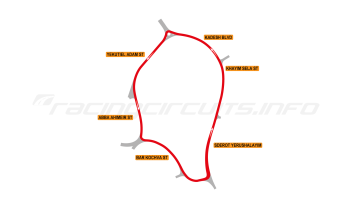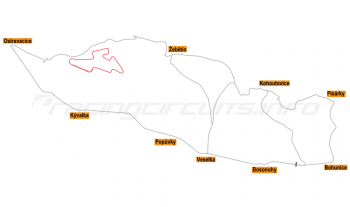Killarney
Circuit Overview
Cape Town’s Killarney circuit is one of South Africa’s longest-lived and, after nearly 70 years of continuous operating, is today returning to its heyday with the advent of international motorsport once more.
Subject to continuous improvements over the years, the circuit now boasts two pit lane complexes on either side of the main straight.
As well as the usual categories of two and four-wheeled circuit racing, Killarney hasn't been afraid to innovate and hosted the FIA World Rallycross Series from 2017 using a new course centred around Turns 2, 3 and 4.
Circuit History
Motor racing began in the Cape in 1928 when the Mets (Metropolitan Motorcycle and Car Club), originally a predominantly motorcycle outfit, was formed. It was followed in 1938 by the AARC (Amateur Automobile Racing Club), one of the other partners in the eventual coalition of the four clubs that formed the WMPC (Western Province Motor Club).
Humble beginnings
It was the AARC that spotted the potential of an interesting development when the Cape Divisional Council bypassed what was then the main road to Malmesbury at the Potsdam Outspan. In 1947 they got permission to organise motorsport events on the disused stretch of road, which served as a makeshift drag strip. A section of this original road, flanked by bluegums on each side, still serves as the access road from the main gate to the subway, used on race days only.
The Mets Club soon took over from the AARC and several years passed with the members enjoying speed trials on the curving road. Their appetite was truly whetted and in September 1950 the Mets proudly announced they had purchased 51 hectares of council land for a nominal sum, on the condition that a true circuit was developed.
Although the Mets had no real money to speak of and development included the removal of acres of bushes and scrub before any sort of circuit could be built, the members organised weekend work parties to get the job done. When the clearing was completed, local farmers who were members brought their machinery to help with the circuit construction.
The completed circuit was around 1km in length and roughly triangular with a tight hairpin at one end, the remains of which can still be seen in the spectator area to the south of Malmesbury/Sabat Corner. It may not have been much, but these humble beginnings would firmly establish Killarney Circuit (named after the Killarney Hotel in the local area) for years to come.
Circuit expands
Ambitions soon grew and in 1952 the Tower Bend and the Big Sweep were built. The potholed remains of these corners are today incorporated in the stretch of tarmac that circumnavigates the clubhouse, from the subway to the infield area. An urban motorsport legend has it that Billy Kay, the then chairman of the Mets, painstakingly measured the new circuit with a dressmaker’s tape measure. He eventually concluded it was 5,562 ft. 9 ins. long, (1.65km) though how long this took him is lost in the annals of time!
Killarney was raced in this form for several years before the final addition to the “old” track, when a loop down towards what is now the Cape Town Corner, was constructed in November 1954. Before this was completed there was considerable discussion as to where the Start/Finish should be located. It was finally agreed that this key position would be sited pretty close to where it is today, although all events on the original circuits were raced in an anti-clockwise direction. The lap distance was now a more respectable 2.687 kms.
During this period the motocrossers who had begun on the beach and in the dunes at Noordhoek and Sandvlei, also joined the WPMC. Finally, with the formation of an active Drag section, Killarney became the first true motor sport complex in South Africa.
Grand Prix dreams realised
In 1959/60 the club negotiated a loan of R40,000 with the Cape Divisional Council for the purpose of building a new circuit to the then Formula One International Standard. Edgar Hoal penned the design and supervised the construction, utilising part of the new loop to Cape Town Corner but little else.
The new course completed ahead of time in December 1960. It was fast and flowing and marked a considerable step forward from what had come before. Particularly challenging was the double-apex Malmesbury Corner, which required a good exit onto the long back straight. A drag strip was incorporated into the start-finish straight, providing additional versatility.
The goal was to bring international racing to the Cape and the dream came true on December 17, 1960, when a selection of international drivers lined up for the first Cape Grand Prix. Run to Formula Libre rules, it nevertheless included a smattering of Formula One cars, including the works Porsche team of Stirling Moss and Jo Bonnier and the Team Lotus entry of Wolfgang von Tripps. The race was run over 72 laps of the circuit, and was just won by Moss. Bonnier came in second with the fastest lap, with von Tripps in third. Top local driver was Bruce Johnstone, who came fourth in his Cooper-Alfa Romeo.
Unfortunately, the weather Gods were not on side and a howling south-east wind blew sand everywhere from the recently cleared surroundings, which had no undergrowth to bind it. Several racing engines were damaged and it had an effect on crowd numbers, with disgruntled spectators left with a poor impression of the new facility.
Nevertheless, the next Grand Prix was run just over a year later on January 2, 1962. Again, Lotus and Porsche sent their works teams, this time featuring Jim Clark and Trevor Taylor, and Jo Bonnier and Edgar Barth respectively. A thrilling race was dominated by Taylor and Jim Clark, and they swapped the lead several times after Jo Bonnier had initially held the top spot for the first three laps. Clark suffered a spin and Taylor was able to keep the lead for the last ten laps to take the victory.
The events had been a success in terms of exposing Killarney to an international audience, but it was a financial bloodbath for the promoters and organisers, who had over-stretched their finances to make the dream come true. Both events had been run at a loss, leaving the promoter unable to pay anything to the Mets Club for the hire and preparation of the circuit. This in turn meant the club could not meet its annual loan repayments to the Divisional Council.
Things came to a head on November 30, 1964, when the Mets Club was informed that the Divisional Council had cancelled the lease and loan agreement and would retain ownership of the land and any improvements that had been affected.
Realising that they would have to somehow find the resources to repay this loan, the Mets formed a new committee to firstly find the money and then to invite the existing clubs in Cape Town to bury their differences and their individual identities in a new, strong, unified club for the good of motor sport. Adrian Pheiffer was chairman and Denis Joubert was the secretary. With the enthusiastic support of many other club members they successfully organised a major eight day Argus Motor Show Extravaganza at the Goodwood Showgrounds. The event was a huge success and raised money to repay the debt.
WPMC is formed
Thereafter amid some die-hard opposition from some older Club members the Mets, the AARC, the Cape Rally Association, the Kape Kart Klub and the MotorSports Marshals Association combined to form the Western Province Motor Club. The first Chairman was Adrian Pheiffer, who was followed by Ted Lanfear, Ronnie Hare and Denis Joubert.
Over the years, facilities were added. Benefiting from the Tex Kingon Committee’s unfortunate experience in the early sixties, the WPMC never overreached itself and an ultra-conservative finance committee led by Joubert always ensured that the money was available to meet any commitment.
The Joubert reign eventually spanned an incredible 36 years. It was aided by his architectural ideas and prowess that resulted in the construction of the open and closed pits and an ever increasing number of garages that are leased to competing members. A string of company hospitality areas sprang up around the track at about the same time. There was also the clubhouse that progressed as funds became available and eventually was only initially completed after more than two years. There have since been several more changes and improvements, including the introduction of short oval racing and a further short course variation on the western side of the track. The imposing new pit block, restaurant and viewing stand, on the other side of the start/finish straight, was his final effort before retiring.
Killarney went on to stage a series of sports car endurance races as well as national championship racing car meetings over the years, with the Sasol GTC series one of the current highlights. In 2017 the circuit also debuted on the FIA World Rallycross Series and has become a regular fixture, on a new course centred around Turns 2, 3 and 4. It marked the first World Championship event in South Africa since the 1993 Grand Prix at Kyalami and the first ever world series motorsport date to be allocated to the Western Cape.
Jump onboard
Circuit info
- Killarney International Circuit, P.O.Box 220, Table View, 7439, South Africa
- +27 21 557 1639
- Email the circuit
- Official website
Rate This Circuit
Votes: 1261
Get your race tickets!
Brought to you with: 
We've teamed up with Motorsports Tickets to bring you the best deals for Formula One, MotoGP, Le Mans and more.
























